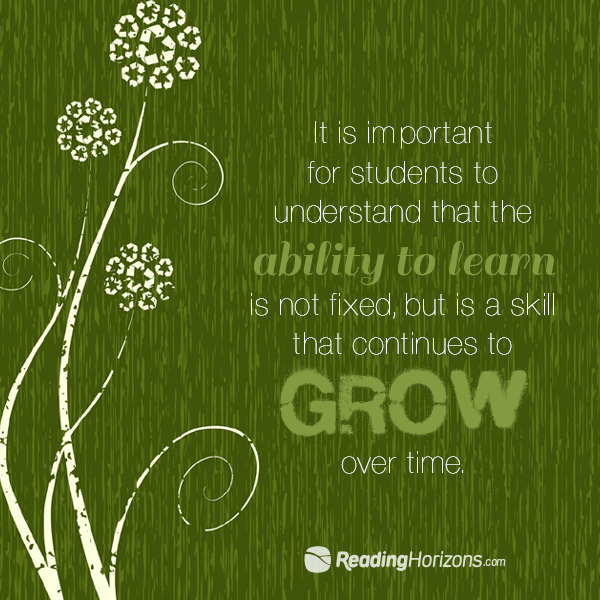How to Promote Metacognition in the Classroom
By Guest Writer, John Mendes, Ed.D.
A crucial component of learning is being aware of our own thought processes and consciously understanding how we filter new information. This information allows us to have a better cognitive understanding of how our mind works, and this self-awareness will increase our overall learning efficiency. This insight allows learners to scaffold, using background knowledge to better utilize learning strategies with focus and intent. Metacognitive skills are imperative in today’s classrooms, as we are preparing students to be tomorrow’s leaders and problem solvers. Below are activities and examples that can help increase metacognition in the classroom.
Learn more about teaching reading strategies ›
Tips for Increasing Metacognition in the Classroom
Avoid a “Fixed Mindset”
 It is important for students to understand that the ability to learn is not a fixed quantity, but a skill that continues to develop over time. Experts believe in the importance of understanding that one can achieve a Growth Mindset (Dweck, 2006), which is based on brain plasticity. Neuro- or brain plasticity is the belief that the brain is “plastic” and has the ability to adapt and change depending on positive and/or negative experiences. In the not so distant past, experts believed that brain development primarily took place in childhood and reached a point of maximum capacity by early adulthood. New research and innovative technology has shown that the brain continues to be malleable and changes with new information, experiences and memories. Current research supports the belief that optimism and positive experience(s) can strongly impact the brain and enhance the learning process.
It is important for students to understand that the ability to learn is not a fixed quantity, but a skill that continues to develop over time. Experts believe in the importance of understanding that one can achieve a Growth Mindset (Dweck, 2006), which is based on brain plasticity. Neuro- or brain plasticity is the belief that the brain is “plastic” and has the ability to adapt and change depending on positive and/or negative experiences. In the not so distant past, experts believed that brain development primarily took place in childhood and reached a point of maximum capacity by early adulthood. New research and innovative technology has shown that the brain continues to be malleable and changes with new information, experiences and memories. Current research supports the belief that optimism and positive experience(s) can strongly impact the brain and enhance the learning process.
Here's a video of Professor Carol Dweck discussing how to help students (and educators) develop a growth mindset:
 Modeling the “Thinking Process”
Modeling the “Thinking Process”
As we know, modeling is a critical instructional strategy that promotes a better understanding of previous concepts and learning new information. Effective modeling epitomizes the teacher-student relationship and is valuable to cognitive growth. When modeling, teachers need to verbalize and clearly communicate “how” and “why” they are using specific strategies when problem-solving. This communication should include a step-by-step explanation of what the teacher is thinking and doing. During this process, constant questioning, communication and feedback is vital.
Learn how this type of explicit instruction can apply to phonics instruction ›
Activating “Background Knowledge”
During this process, the objective is to create a connection between new information and previously learned the material in a meaningful and relevant manner. This is best done during the anticipatory set of a lesson to ignite curiosity and enthusiasm. During this time, teachers should clearly communicate the value and vision of the lesson and why it is worth learning. Creating goals and objectives for academic tasks (class and homework) will give a purpose and increase student productivity.
Reflection and Analysis: “What You Know vs. What You’ve Learned”
Pre-assessing enables students to have a better understanding of what they know and what they need to learn. It defines a sense of strengths and weaknesses in a particular academic area, which is key to metacognition in the classroom and the learning process. Utilizing (daily) Reflective Journals allows students to monitor and regulate their own thinking and learning. Throughout this process, students record thoughts and insights related to their individual learning experiences. This encourages learners to analyze and examine used (learning) strategies, assess performance, and better plan for future learning experiences. With this, students are taking accountability for their “own” learning and developing into life-long learners. At the conclusion of a lesson/unit, a Post-Assessment allows students to assess their overall progress and recognize a conceptual change. It provides a platform where students can better understand the new knowledge they’ve acquired and what strategies were used along the way.
An Environment that Supports Metacognition in the Classroom
As teachers, we want to establish an environment that encourages “thinking awareness.” Providing an environment where students feel comfortable attempting new feats and utilizing innovative strategies is imperative. With this, the metacognitive learning environment should encompass constant and deliberate communication, collaboration and feedback. Using a Problem Based Learning (PBL) model enables students to utilize these metacognitive strategies to effectively solve problems and become sound 21st-century learners. As the world of education continues to evolve, teachers need to cultivate and equip students with these skills that will promote life-long learning and future success.
Learn how Reading Horizons elementary reading curriculum and reading intervention program helps students better understand the thinking processes needed to properly break words apart into their proper sounds and syllables.
ADDITIONAL POSTS BY DR. JOHN MENDES
Five Ways to Activate Student Attention, Anticipation, & Interest During a Lesson
Reading Fluency... Is It Really That Important?
REFERENCES
Dweck, C. S. (2006). Mindset: The New Psychology of Success. New York: Random House.
